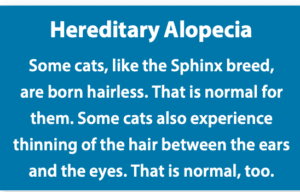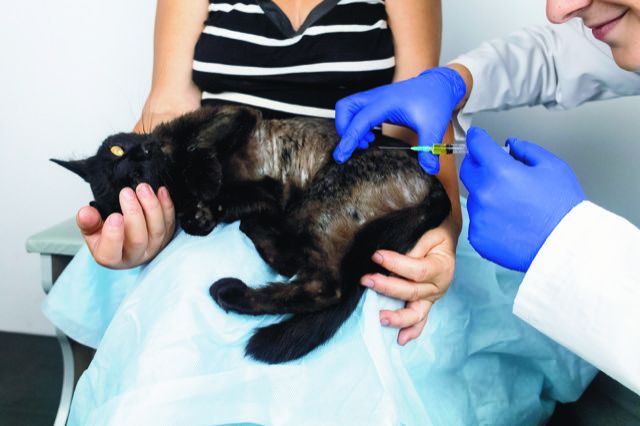You’ve noticed your cat has started losing hair, perhaps in one spot, perhaps in a number of areas on her body. It’s alarming because a cat’s fur is so much a part of her appearance. Fortunately, the reason for a cat’s hair loss, known medically as alopecia, can almost always be found. Once it is, effective solutions are available. Here are five reasons that a cat would lose hair — and how to address the problem.
Allergies. A cat can be allergic to fleas (specifically, flea saliva when the insect bites), airborne allergens like dust mites and pollen, or, in rare instances, food (specifically, certain proteins in food). The allergy wears itself on a cat’s skin, causing dermatitis — inflammation and itching. And it can drive a cat to distraction and cause her to rip out her hair through biting and scratching.
Solution: Once the vet works backwards to determine the cause of the allergic reaction, it can be effectively addressed and the cat will stop tearing her hair from her body. For instance, fleas can be killed (and warded off) with topical preventatives such as Bravecto, Revolution, and Advantage II. Environmental allergies can often be controlled with medications like corticosteroids. And prescribed diets with “extremely hydrolyzed” or “novel” proteins have been successful at quelling food allergies.
Hormonal disease. Both hyperthyroidism and hypothyroidism (too much or too little thyroid hormone, respectively) can lead to hair loss in cats — not because the cat pulls at fur but because the hair simply falls out. The often patchy hair loss of hyperthyroidism results from excessive grooming or a shrinkage of hair follicles from too much hormone. With hypothyroidism, hormone insufficiency leads to arrested hair growth.
Solution: Once a thyroid hormone imbalance is identified, medication can be given either to block excess hormone production or stimulate production, depending on which problem it is. A special therapeutic diet can also be prescribed to treat hyperthyroidism.
Fungal or Bacterial Infection. If a cat has ringworm (an infection from a fungus that can flourish in a cat’s haircoat) or an infestation of bacteria, it can do what fleas do — make her very uncomfortably itchy to that point that by licking and scratching and biting at her skin, she can end up ripping out her hair. Inflammation from the infection can also make hair fall out.
Solution: Appropriate medicines can eradicate infection-causing invaders. Antibiotics can take care of a bacterial infection, and an anti-fungal drug called itraconazole can get rid of ringworm. That said, most of the time there is another disease process going on that predisposes a cat to these infections, so most cases will need a workup to figure out the root cause.
 Disease inside a cat’s body. Sometimes what makes a cat’s coat uncomfortable and causes her to scratch and bite at herself is not an issue on her skin but somewhere else. Discomfort from kidney or bladder disease, for instance, or a problem elsewhere in the gastrointestinal tract can make a cat start licking or scratching. Even a fever can play out on the skin, as can joint pain from arthritis.
Disease inside a cat’s body. Sometimes what makes a cat’s coat uncomfortable and causes her to scratch and bite at herself is not an issue on her skin but somewhere else. Discomfort from kidney or bladder disease, for instance, or a problem elsewhere in the gastrointestinal tract can make a cat start licking or scratching. Even a fever can play out on the skin, as can joint pain from arthritis.
Solution: Alopecia is often not the first sign of a problem going on internally, but whatever the issue is, once it is treated, the cat will stop reacting and her hair should grow back.
Stress. Sometimes a cat will pull at her hair with her claws or teeth because she is emotionally stressed. This is called self-trauma, or psychogenic alopecia (“psycho” meaning “mental” and “genic” meaning “origination”). It’s not a frequent occurrence, but a cat can end up pulling out so much hair that she ends up with significant bald spots rather than just coat thinning. Making the problem more difficult is that even after the cause of the stress is addressed — the visitor who has come to stay for 6 months leaves or the person the cat loves has come back from a long trip — the behavior may have become so compulsive that the cat may not stop.
Solution: Modifications to a cat’s environment may help, but sometimes psychotropic medications in the form of mood stabilizers are necessary.




